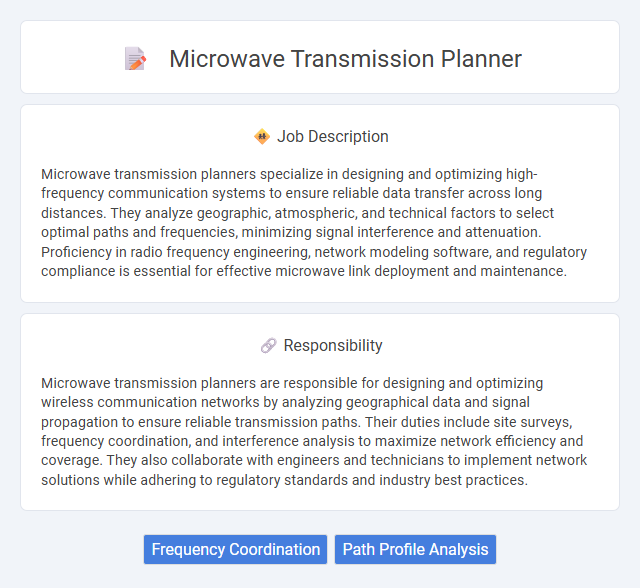
Microwave transmission planners specialize in designing and optimizing high-frequency communication systems to ensure reliable data transfer across long distances. They analyze geographic, atmospheric, and technical factors to select optimal paths and frequencies, minimizing signal interference and attenuation. Proficiency in radio frequency engineering, network modeling software, and regulatory compliance is essential for effective microwave link deployment and maintenance.
Individuals with a strong technical background and problem-solving skills are likely to be well-suited for a Microwave Transmission Planner role due to the job's reliance on detailed network analysis and planning. Those comfortable with fieldwork and complex data interpretation might find the conditions favorable, as the position often requires precision and adaptability in varying environmental settings. Candidates who prefer routine tasks or lack interest in telecommunications infrastructure could potentially face challenges in meeting the dynamic demands of this career.
Qualification
Microwave transmission planners require a strong background in telecommunications engineering or a related field, often holding a bachelor's degree in electrical engineering, computer science, or information technology. Proficiency in RF design, network planning software such as Atoll or Planet, and understanding of microwave link parameters including link budget, Fresnel zones, and path profiles are essential. Certifications like Cisco CCNA or Certified Wireless Network Expert (CWNE) enhance job prospects and demonstrate expertise in microwave network planning and optimization.
Responsibility
Microwave transmission planners are responsible for designing and optimizing wireless communication networks by analyzing geographical data and signal propagation to ensure reliable transmission paths. Their duties include site surveys, frequency coordination, and interference analysis to maximize network efficiency and coverage. They also collaborate with engineers and technicians to implement network solutions while adhering to regulatory standards and industry best practices.
Benefit
Microwave transmission planner roles likely offer significant benefits such as competitive salaries and opportunities for career advancement within the telecommunications industry. Employees may experience enhanced technical skills and professional growth due to involvement in designing and optimizing wireless communication networks. The position probably provides a stable work environment with potential exposure to innovative technologies and collaborative projects.
Challenge
Microwave transmission planners likely face the challenge of accurately predicting signal pathways in complex terrains, which can cause interference and signal loss. The role probably demands constant adaptation to evolving technologies and regulatory standards, increasing the complexity of network design. Ensuring reliable connectivity while optimizing resource allocation may pose ongoing difficulties in project execution and troubleshooting.
Career Advancement
A Microwave Transmission Planner plays a critical role in designing and optimizing wireless communication networks to ensure efficient signal propagation. Career advancement in this field often involves gaining expertise in emerging technologies, such as 5G networks and IoT integration, which increases demand for advanced planning skills. Professionals can progress to senior engineering roles, project management positions, or specialized consultancy roles within telecommunications companies or network infrastructure providers.
Key Terms
Frequency Coordination
Microwave transmission planners specialize in frequency coordination to optimize spectrum usage and prevent interference in wireless communication networks. They analyze frequency assignments, regulatory guidelines, and interference patterns to ensure compliance with FCC and international standards. Precision in frequency coordination enhances network reliability and maximizes the efficiency of microwave links in telecommunications infrastructure.
Path Profile Analysis
Microwave transmission planners specialize in path profile analysis to ensure optimal line-of-sight communication between microwave towers, using topographic and environmental data to identify potential obstacles or signal losses. They utilize advanced software tools like radio propagation models and GIS mapping to evaluate terrain elevation, Fresnel zones, and weather impacts on signal quality. Accurate path profile analysis is critical for designing efficient microwave links with minimal interference and maximum reliability.
 kuljobs.com
kuljobs.com